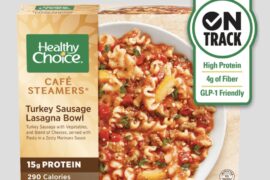In the 1940’s, tin containers were extremely popular as a means of preserving food for extended periods of time. However, given the fact that heavy rationing of tin plate was imposed during World War II, frozen food packaged in paperboard cartons began to emerge as a credible alternative for manufacturers.
This accelerated during peace time, as the business case for frozen foods remained strong. Fully automated cartoning machines then available on the market were capable of packaging a wide variety of frozen goods – including the first generation of TV dinners, fish fingers, pizzas and of course, ice cream.
 As the trend towards packing frozen food in cartons continued to gather momentum, many more products were brought to the market that required packaging providers to innovate and adapt to clever pack styles, shapes and formats. New machines were needed – and subsequently developed – to accommodate products that required some entirely unique packaging. Paperboard converters, carton designers and machinery engineers worked in partnership to develop the next generation of packaging for the sector. This collaborative effort continues into the present day.
As the trend towards packing frozen food in cartons continued to gather momentum, many more products were brought to the market that required packaging providers to innovate and adapt to clever pack styles, shapes and formats. New machines were needed – and subsequently developed – to accommodate products that required some entirely unique packaging. Paperboard converters, carton designers and machinery engineers worked in partnership to develop the next generation of packaging for the sector. This collaborative effort continues into the present day.
Frozen Market Growing Globally
On the eve of 2018, the frozen food sector as a whole has been valued at £8.3 billion in the United Kingdom. In the USA sales reportedly topped $53 billion last year, while the total value of frozen foods sold globally is pegged at $275.8 billion by Allied Market Research. It forecasts that sales will grow approximately 4.2% annually through 2025.
 The advances made by pioneering packaging companies allow a vast number of products to be packaged and frozen using paperboard substrates, ensuring production targets are hit and retailer and consumer demands are met in a profitable manner.
The advances made by pioneering packaging companies allow a vast number of products to be packaged and frozen using paperboard substrates, ensuring production targets are hit and retailer and consumer demands are met in a profitable manner.
For items such as beef burgers, fish fingers, ice lollies and a wide variety of everyday products, top-load carton formers and closers are required. Carton formers available on the market today must have the capability to combine lock-style or glue-style cartons on the same machine, with a dramatic increase in speed: up to 120 cartons per minute with a single carton forming head. Ergonomic waist-level hoppers allow for easy carton loading, while state-of-the-art touch screen HMIs are used for ease of operation.
 Right angle, straight line and variable pitched carton closing systems have been developed to accommodate all lock and glue carton style formats and certain machines feature highly advanced technology, such as the “pop-up lug” device. This ensures that a lug is only prompted when a carton is present, providing the benefits of lugged carton control and random infeed timing, allowing for a broad carton size range.
Right angle, straight line and variable pitched carton closing systems have been developed to accommodate all lock and glue carton style formats and certain machines feature highly advanced technology, such as the “pop-up lug” device. This ensures that a lug is only prompted when a carton is present, providing the benefits of lugged carton control and random infeed timing, allowing for a broad carton size range.
Items such as frozen quiches, pizzas, pies and ready meals are often packaged using end-load cartoners, and require a high level of precision. These systems must combine the need to encompass large-scale food production with specific application requirements. Exact speed and size ranges must be taken firmly into consideration, ensuring that performance is consistent, predictable and fully optimized from a productivity perspective. This level of detail provides manufacturers with the confidence they require in their capital equipment investment. Changeovers are fast and unplanned downtime must be minimized, along with material wastage percentages.
Finally, for ice cream products or tubs and pots that call for a sleeve, a wrap-around cartoner may be used. The technique uses reduced carton board, making it a very economical packaging format without diminishing the shelf appeal that is highly popular with brands. Items can be packaged individually, in single or double row configurations, or even stacked multi-packs. A carton blank is placed on top of the product and is then folded around the product and glued underneath to form the final package. Many shapes and styles can be accommodated, depending on individual needs and requirements.
With retail sales growth set to continue apace, packaging equipment options available to manufacturers of frozen products will ensure their production lines remain productive and that increased demand will be met. – Reported by Michelle Newman
 [Editor’s Note: Based in Bristol, England, the author is the marketing manager and sales support administrator for the Kliklok International unit of Bosch Packaging Technology. Headquartered in Waiblingen, Germany, Bosch is a leading supplier of process and packaging technology to the food industry worldwide.]
[Editor’s Note: Based in Bristol, England, the author is the marketing manager and sales support administrator for the Kliklok International unit of Bosch Packaging Technology. Headquartered in Waiblingen, Germany, Bosch is a leading supplier of process and packaging technology to the food industry worldwide.]





